Table of Contents:
- How to Grow Cannabis 101: An Introduction to Cultivation
- Cannabis Greenhouse vs. Indoor Grow
- Minimizing Indoor Grow Costs
- How to Maximize Cannabis Yields
- Cannabis Greenhouse Construction Process
- Cannabis Cultivation Equipment
- Planning a Cannabis Cultivation Facility
- The Unique Challenges of Cannabis Cultivation
- VPD Dehumidification & Cannabis Cultivation
- Light and PAR
- Cannabis Irrigation
- Top 20 Cannabis Growing Questions – FAQ
- Glossary of Terms: Cannabis and Hemp Extraction
- Industry Resources
Which is best for your Cannabis Cultivation Project: Indoor Grow or Hybrid Greenhouse?
What does it mean to cultivate cannabis in an indoor grow warehouse? The phrase itself invokes an image of basement operations melding with controlled environmental agriculture—and perhaps that’s exactly what it is: typically a nondescript warehouse space converted into an indoor greenhouse utilizing artificial light instead of sunlight.
As the cannabis cultivation industry has evolved, its practitioners have come from a wide range of professional backgrounds along with an explosion of advanced horticultural technology. The unique melting pot that cannabis has found itself in has created the indoor grow as we know it. But it’s not just a converted warehouse. The term “indoor grow” encompasses a spectrum of cultivation ranging from hybrid greenhouses to vertical farm indoor warehouses—and everything in between.
Table of Contents:
This article provides an overview of this spectrum, including greenhouses, hybrid structures, and warehouse indoor grow facilities—that you may want to consider for your next cannabis cultivation project:
2. What type of Indoor Grow Structure will Suit my Operation?
3. Greenhouse or Warehouse? An Age-Old Question
6. Capital and Operational Costs
7. Current Trends and Expectations
What is an Indoor Grow?
What makes a facility an indoor grow is that it offers protection from the outdoors and has the ability to control its environment. An indoor grow can cultivate cannabis year-round with 4-6 harvests per year, whereas an outdoor production may get 1-2. There’s a broad definition of what exactly constitutes an indoor grow and there is a range of facilities that can be included in this classification.
These categories can be broken down into four primary groups consisting of hybrid and sealed greenhouses, along with single and multi-tier warehouses. This ordering describes the transition from using outdoor air to economize versus dehumidification technology, transparent versus opaque roofs, and vertical tiered rack cultivation.
The Spectrum of Greenhouse through to Indoor Warehouse Grow
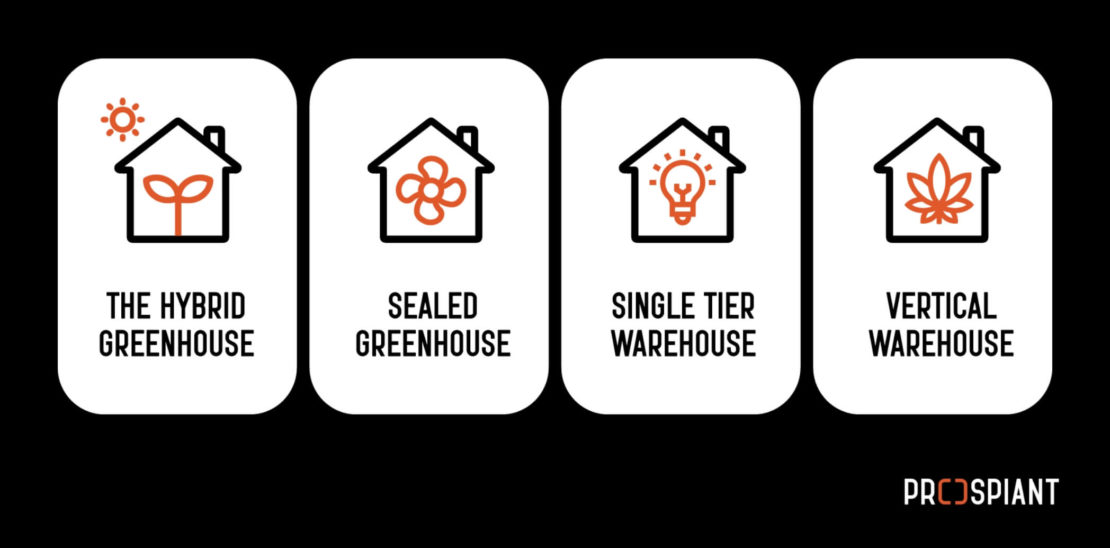
What type of indoor grow structure will suit my operation?
When choosing what style of indoor cannabis grow system to construct for your particular operation, an array of factors will drive the verdict. You must weigh the balance of capital and operational costs while being honest about your capabilities to manage the “plant factory” you’re purchasing. Indoor grows don’t run themselves.
Some decisions may be made based on geographic climate and your specific state’s regulations. The degree to which the environment is controlled is often associated with the desired final product—boutique flower requires greater care than extracted oil. There is no one-size-fits-all approach to cannabis cultivation construction, and what is successful today may not be profitable tomorrow. Staying adaptable to the changing market forces is critical.
To better help you decide on what your future cannabis cultivation facility will look like, we will break down each of these indoor grow solutions by:
- Describing their ability to control the environment and impact on yields
- Calculating the costs of construction
- Estimating operational efficiency
- Regulatory requirements
The Hybrid Greenhouse
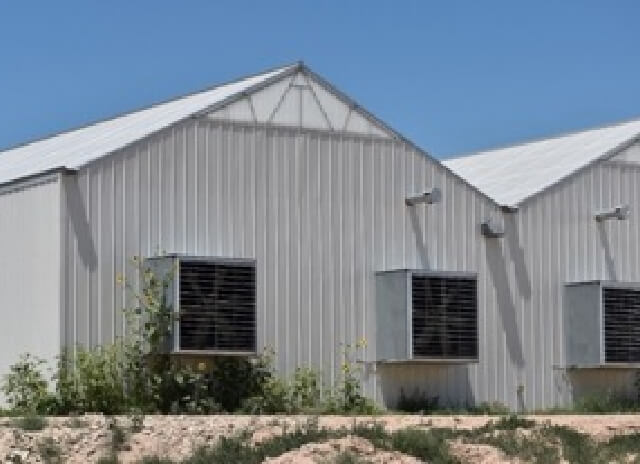
The Hybrid Greenhouse delivers the quality control of an indoor warehouse with the operational efficiency of a traditional greenhouse. Corrugated polycarbonate coverings provide free full-spectrum sunlight directly to the cannabis canopy, and when this sunlight is unwanted, light deprivation screens blackout the zone.
The exterior sidewalls of the hybrid greenhouse are made from insulated metal panels, which prevent both light and intruders from entering. The facility’s interior is broken out into separate growing zones and gutter-connected through a central corridor that allows for workplace efficiency and product isolation.
Hybrid greenhouses can be engineered to handle extreme weather conditions including snow, wind, temperature, and humidity.
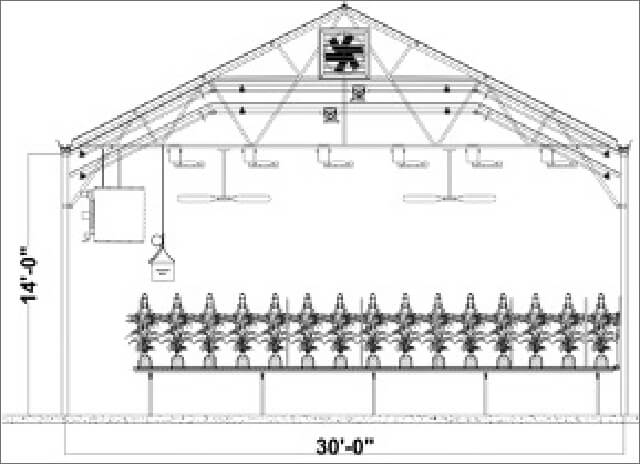
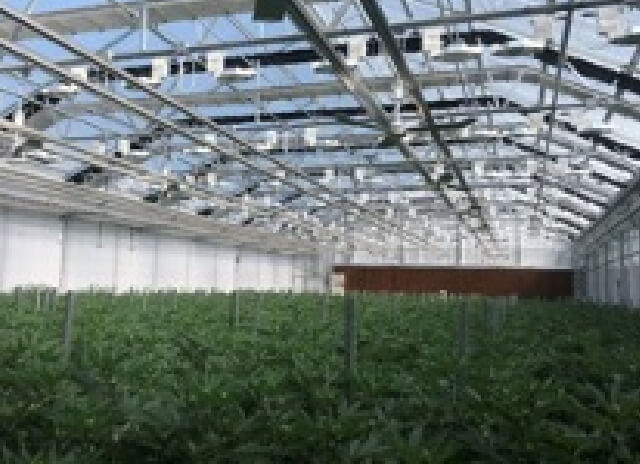
The driving force behind the hybrid greenhouse is the airflow created by the exhaust fans pulling fresh air through the evaporative cooling pads. The greenhouse is engineered in a way that one air exchange per minute is created. This process provides fresh CO2 and breaks up micro-climates across the cannabis canopy. Incoming air is filtered via insect screening, reducing the integrated pest management (IPM) load inside the facility. When the air outside is hot and dry, the evaporative pad can be activated so that air is pulled through, resulting in cooler, more humid air entering the growing environment at a minimal electrical cost.
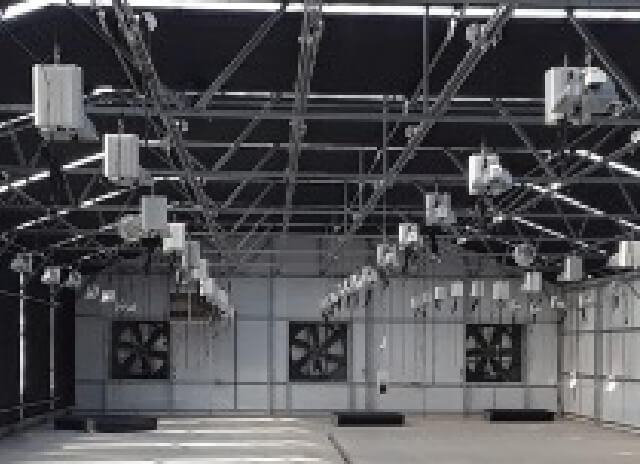
The greenhouse has traditionally been designed to allow as much light as possible to enter the hybrid greenhouse. To allow for proper photoperiod control, light entering the roof is obstructed by a multi-layer curtain. The sidewalls can also use a curtain system yet are typically opaque. Integrated controllers track the positioning of these curtain systems and ensure that once the flowering zone has entered night-time mode, PAR levels are zero at the canopy. Light traps are placed on exhaust fans and evaporative pads to prevent any light from entering the growing environment.
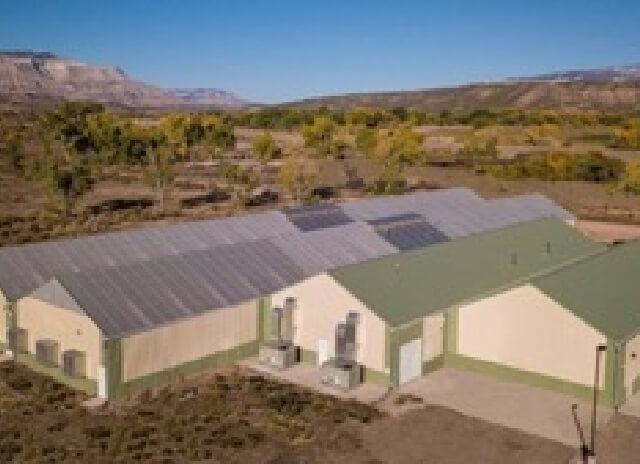
In the winter the hybrid greenhouse can close up to limit air exchange and heat the indoor environment. Temperatures are maintained through unit heaters and optional under bench hydronic fin tube. Dehumidification fans in the upper gable pull humid air in the attic outside and replace it with dry outdoor air.
Odor mitigation can be a major concern, particularly in populated areas. Misting vapor units help keep growing facilities in compliance with municipal laws, resulting in far fewer complaints from neighbors. To control odor, the number of openings must be limited.
The Sealed Greenhouse
The Sealed Greenhouse is a revolutionary concept that brings a new meaning to plant factories. These facilities do not dehumidify or cool using outside air but rather through air handling units. Because there are few active air exchanges, carbon dioxide levels can remain elevated, all transpired water can be collected from the HVAC condensate, and outside contaminants never enter the facility. With total control of the environment, the sealed greenhouse can provide high light levels through the diffused glass covering and high-efficiency LED lights that bring in yields higher than many indoor facilities while also embracing the full-spectrum sunlight.
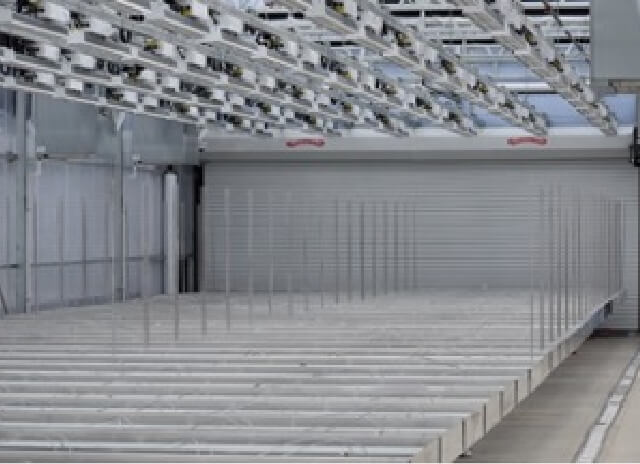
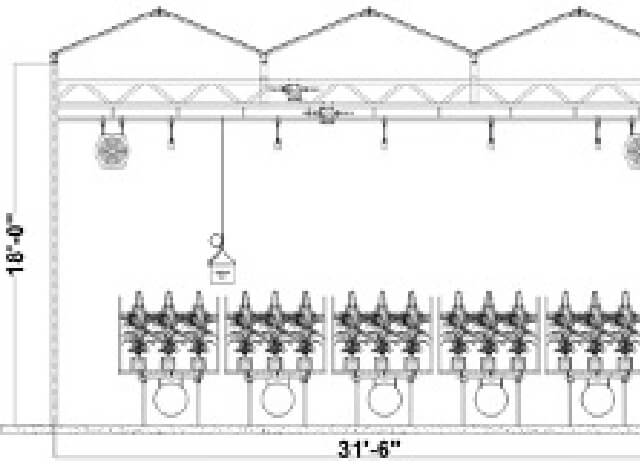
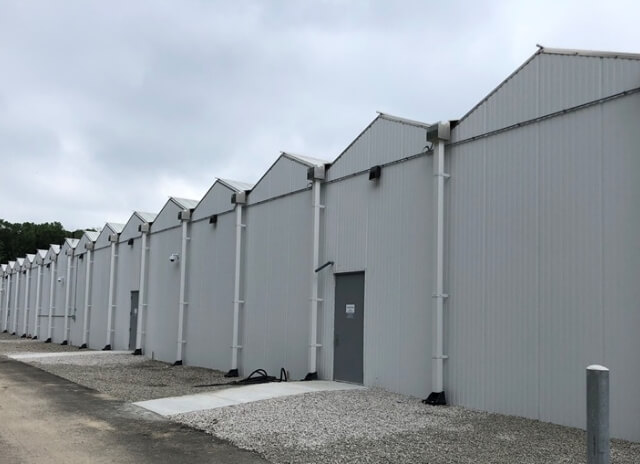
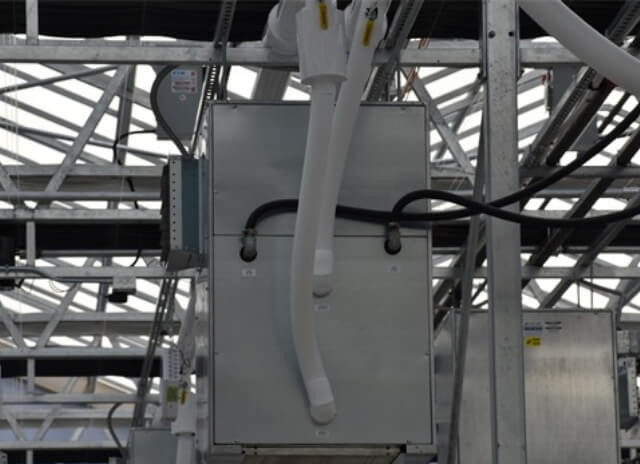
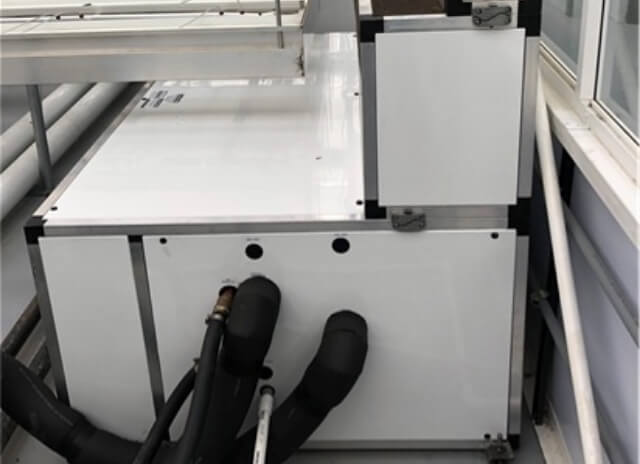
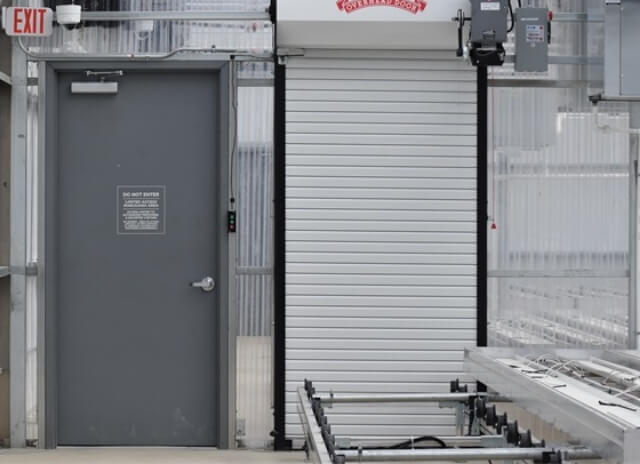
Engineering teams routinely design custom solutions for heating, ventilation, air conditioning, and dehumidification depending on the desired growing environment. The sealed greenhouse requires specialization in high latent load applications where plants transpire large amounts. This dehumidification technology can take shape in the form of DX dehumidifiers, large outdoor standalone desiccant air handlers, or efficient chilled water systems. Conditioned air reaches the plant via duct socks and circulation fans. A proper facility will have the HVAC equipment integrated with the greenhouse environmental control system to ensure proper monitoring and data collection..
Carbon dioxide enrichment has shown to be an economical way to boost yields without the costs associated with increasing light intensity and dehumidification. When air exchanges can be limited, CO2 can be set to a supersaturated level increasing plant growth in greenhouse.. Engineering teams design the distribution systems and evaluate the best method of CO2 generation for the application, whether that be from a burner, tank, or boiler.
Expansive knowledge of growing environments and the water balance allows design teams to create custom water management solutions. Through consultation with the growing team, an irrigation strategy using direct injection or recipe tank fertigation can ensure root zones achieve their desired moisture content, pH, and EC year-round. Tested water samples of the source water and leachate can allow for the design of water filtration and treatment systems to inhibit pathogens and nutrient lockout.
A facility is only as strong as its weakest link, and often the chain connecting everything together is missing entirely. Integrated environmental controls ensure a facility’s equipment can communicate with one another and work in tandem. Not all environmental control companies are compatible with the sealed greenhouse and a complete design is required to determine its proper control strategy and integration.
The Indoor Grow Warehouse
The indoor grow warehouse is the facility that typically comes to mind when one thinks of an indoor grow. These facilities are the most popular type of cannabis operation in the United States and come with a wide range of benefits and disadvantages. Some warehouses are built new, but many are created through retrofit. The warehouse can be split into two categories between single and multi-tier facilities. Those aiming for single-tier are typically looking to minimize the cost they spend per sqft, while multi-tier operators are often trying to maximize the yield they are able to achieve in that same sqft.
The decision to retrofit a warehouse can come very early on and serve as the cornerstone of design. Careful consideration should be made prior to purchase to determine if the facility will meet utility needs and provide the structural capabilities required. Warehouse retrofitting can wipe off months of build schedule and can be priced more competitively than their new counterparts.
New warehouses provide owners the flexibility to properly custom design their facility and can prove to be a much better decision in the long run. The warehouse is typically designed to be tall and with a structure capable of holding rooftop-mounted air conditioning units. Warehouses are also able to have column spacings wider than that of greenhouses, allowing for fewer obstacles.
What makes an indoor grow desirable is its ability to standardize procedures. Unlike the greenhouse where one must worry about seasons and day-to-day weather, an insulated warehouse experiences virtually the same environment day in and day out. This allows operators to create a recipe that works for them and replicate it throughout the country all year long. In the greenhouse, one may need a dozen recipes compared to a single indoor program setting.
Those looking to minimize the cost they put into an indoor grow will lean toward a single-tier system. The single-tier will take shape in the form of floating aisle benches that allow for maximum space utilization, typically 75%-85% of a room’s total square footage. Trellis poles attach to these benches to provide support for SCROG netting.
Single-tier users have historically leaned towards high-pressure sodium (HPS) lighting and in some instances ceramic metal halide for its similarity to the sun’s spectrum. Recently as LED technology has increased in efficiency and white light spectrums, it is becoming more common to see high bay or top light LEDs used in single-tier indoor grows. Many states are taking action against energy consumption by limiting the amount of energy allotted towards grow lighting through lighting power density limits. In some instances, these limits have made it impossible to get high light levels using traditional HPS lighting.
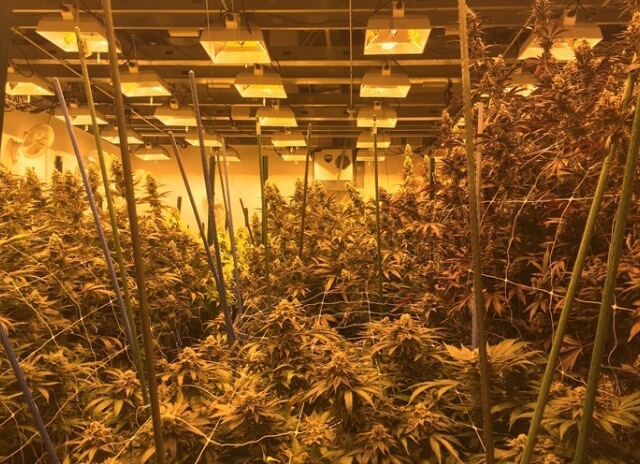
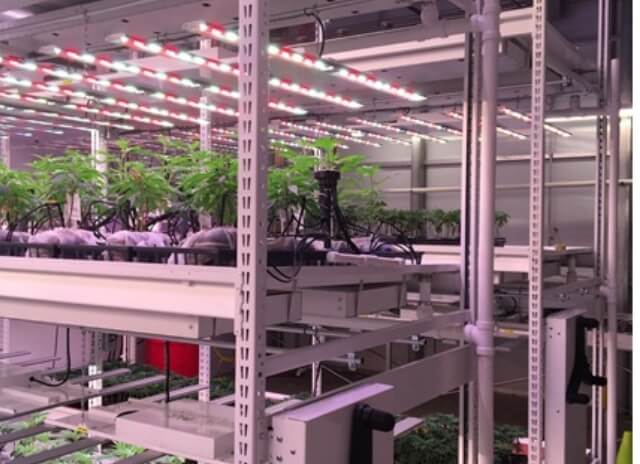
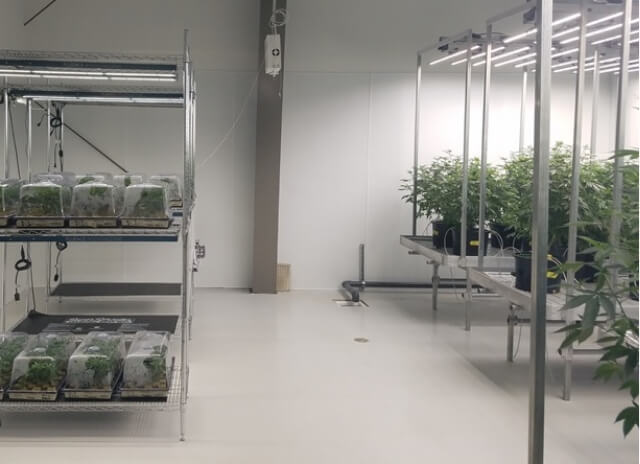
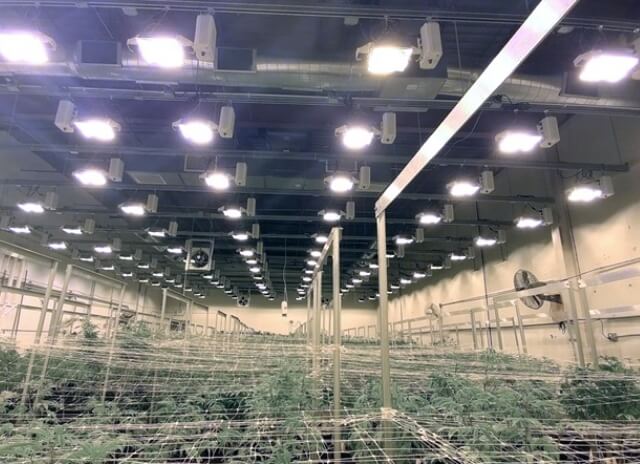
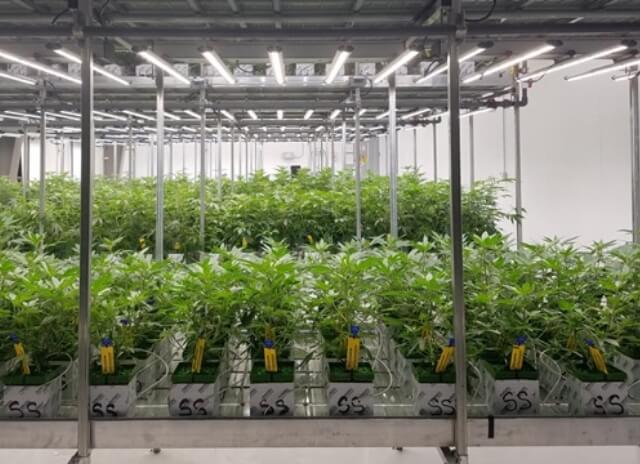
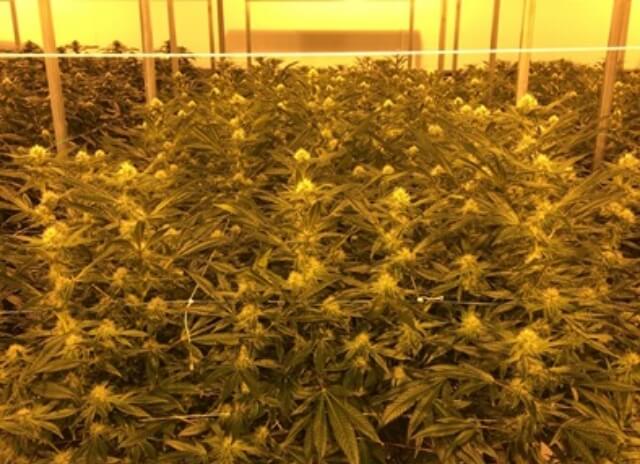
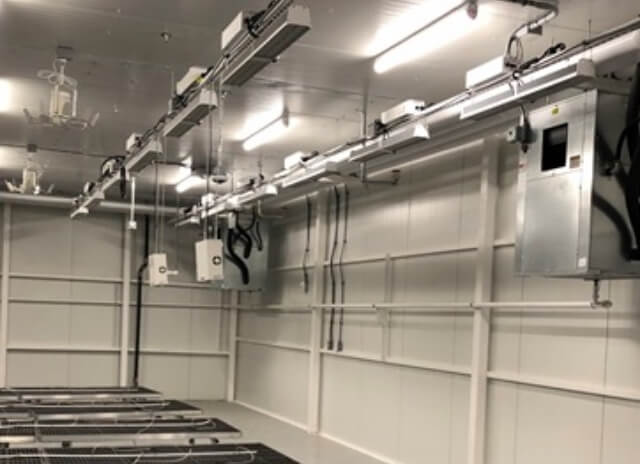
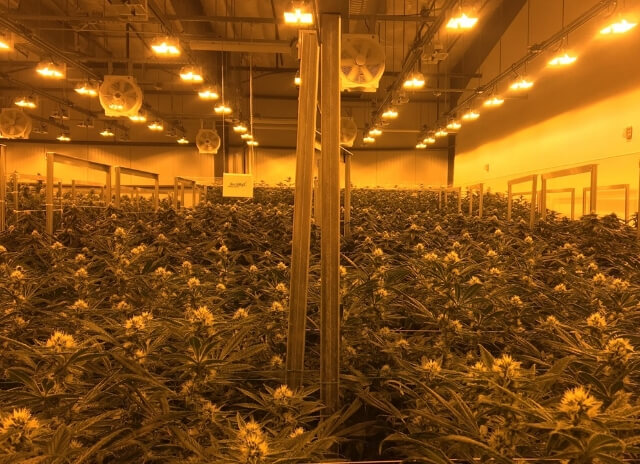
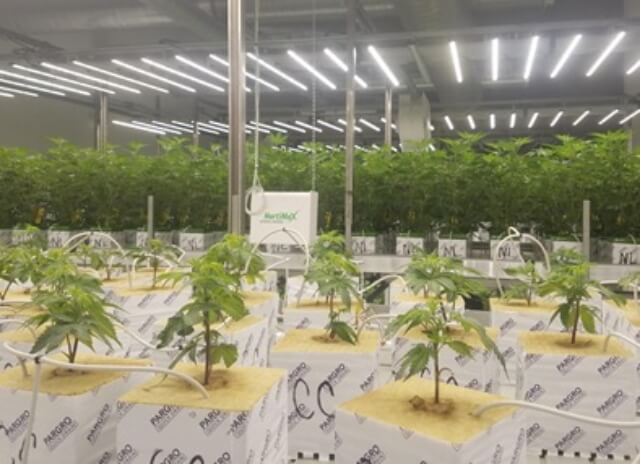
Multi-tier growing has taken off as a way to maximize yield in a given sqft. It is often touted that vertical growing costs less per sqft of the canopy due to the initial infrastructure cost staying constant. While this is true as the number of plants in the space increases, the lighting, irrigation, and HVAC systems must grow as well. Tiered environments face challenges in creating a uniform climate and breaking up the microclimates created in the middle tiers. Careful consideration must also be made for fire codes and irrigation runoff.
In tiered racking, the light source is often only 1-2 feet from the plant canopy, and if it creates too much heat it will cause damage to the plant. This is why in multi-tier racking, the use of bar light LEDs is most common as they evenly distribute light without producing too much heat and burning the plant canopy. Vegetative racks will have shorter tier heights compared to flowering and their light intensity will often be half.
Greenhouse or Warehouse? An Age-Old Question
Any serious cannabis investor will at one point need to make the decision whether to build a cannabis cultivation greenhouse or retrofit a warehouse for indoor grow.
Consultants in the industry will argue till blue in the face for one or the other, but after a decade of legalization later several very obvious trends have begun to emerge towards indoor growing being the environment of choice.
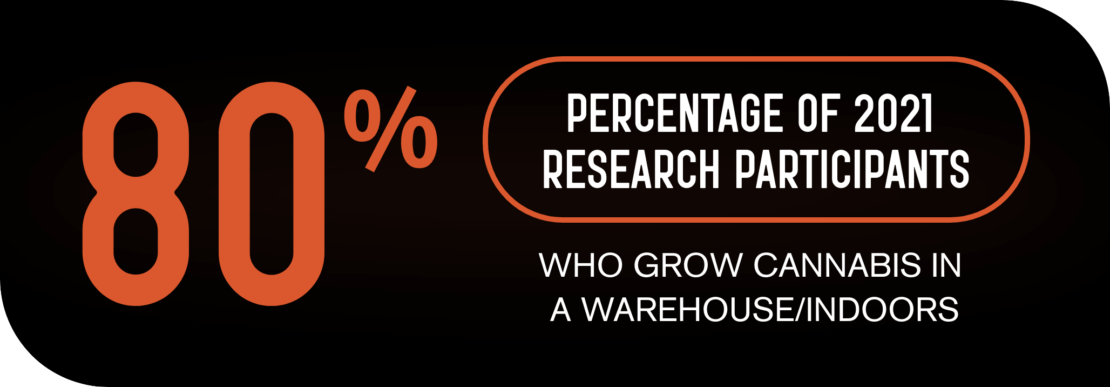
This year’s Prospiant and Cannabis Business Times’ 2021 State of the Cannabis Cultivation Industry Report has revealed a very strong trend toward indoor grow (or a hybrid of indoor & greenhouse) over growing outdoors.
Indoor grows were the dominant operating facilities reported by this year’s research participants. The vast majority (80%) of participants reported cultivation operations taking place in an indoor environment (whether purpose-built or a retrofitted structure), up 20 percentage points from 2020.
Fewer than one-third (30%) of participants reported cultivating cannabis in a greenhouse (either sealed, semi-sealed, hoop house, evaporative pad and fan, or passive), while 35% reported cultivating outdoors. This reverses the increasing greenhouse-use trend seen in previous years. For example, in 2020, 60% of participants reported growing indoors, while 41% said they cultivated in greenhouses.
One explanation for this trend is that as legalization has moved east of the Mississippi River, the environments they are constructed in face higher humidities and dew points. This means that traditional and hybrid greenhouses are limited in their ability to control the environment all year long. Because of these challenges, multi-state operators seeking to standardize their procedures have leaned toward indoor grow warehouse facilities.
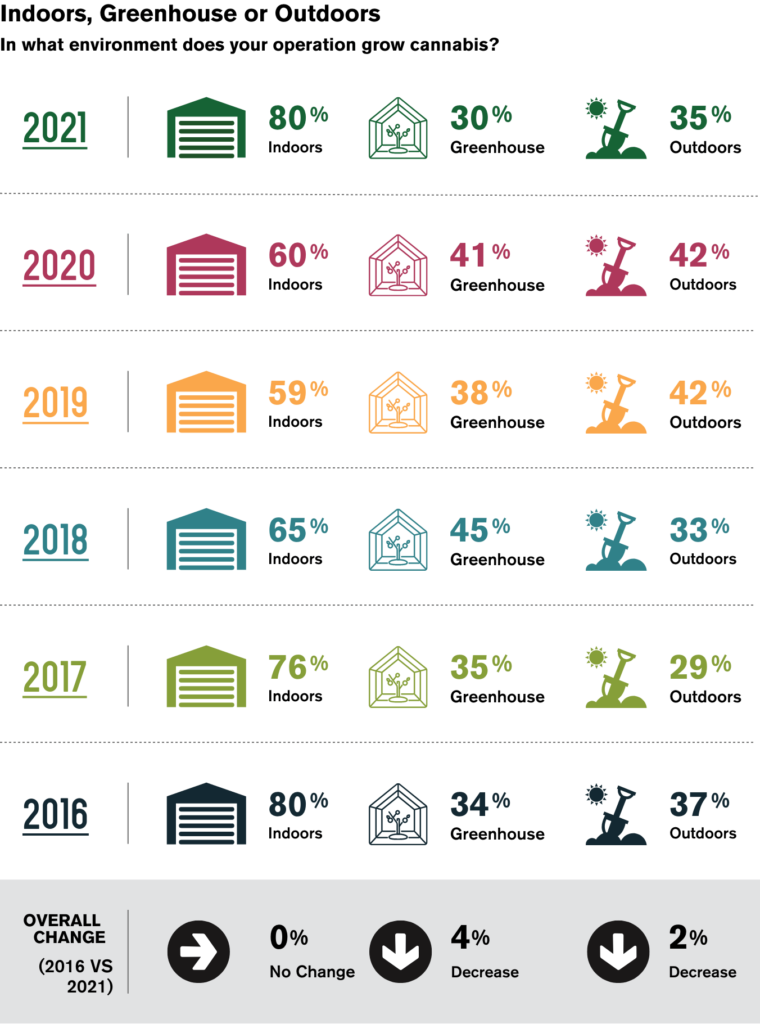
Quality Control
In the cannabis marketplace where quality is king, indoor-grown cannabis commonly sells for twice as much as outdoor-grown. This is due to superior quality control during cultivation.
In the greenhouse space, cannabis typically sells between these two ranges, with polytunnels towards the lower end and controlled environment glasshouses near the top. Even though high-quality greenhouses and warehouses can grow the same quality cannabis, they do so in different ways.
Warehouses grow using all artificial grow lighting, typically done with HPS or LED technology. This contrasts with greenhouses which utilize natural sunlight through a translucent roof, and commercial light deprivation greenhouse systems when darkness is desired.
Greenhouses may still use artificial lights during low solar seasons, but not nearly as many as warehouse facilities.
Another difference is that warehouses are much more insulated as compared with greenhouses. Greenhouses typically use heat in the colder months and nights, whereas warehouses may have to use cooling all year long depending on their climate to counter the heat from HPS lights.
However, warehouses commonly experience humidity problems with their HVAC cooling systems as traditional warehouse equipment is designed for people instead of plants and cannot remove enough water (the facility’s latent load is too high). Greenhouses can overcome humidity issues by having more air exchanges, over one a minute in some scenarios.
Energy Efficiencies
Getting started in cannabis is tough, only the most efficient survive. Decisions made on day one have huge impacts on utility costs for years to come. It is no secret the cannabis industry is a monstrous energy leach, as in Colorado where cannabis consumes 2% of the state’s electricity. Warehouses do excel at insulating their spaces from the outside elements. Greenhouses experience loss of heat during the winter months and solar gain in the summer. To combat this low insulation, controlled environment greenhouses use energy retention curtains and the waste heat from grow lights to supplement their heating systems. In the summer, greenhouses use efficient evaporative cooling systems that take advantage of water’s natural heat of vaporization, cooling the greenhouse without extensive electricity use.
The hybrid greenhouse uses more water than its sealed counterparts. This is due to two primary factors. The first is that it is unable to collect condensate, or the plant’s transpiration, which can account for 80% of what is irrigated. Another aspect is that the hybrid greenhouse uses water to cool via its fan and pad system, this means the hybrid vail uses water resources as opposed to electricity. An evaporative pad system can use as much water as irrigation when being used in a dry climate.
One aspect that surprises many users is the amount of heating used in indoor grow. This heating is required because our plants, in many ways, act as evaporative coolers by bringing liquid water up through their roots and transpiring it as a gas through the stomata. In addition, this water vapor released into the air is typically removed from the environment via cooling, meaning that water vapor condenses on a cold surface, further cooling the air. To prevent the grow environment from becoming too cold additional heat is needed.
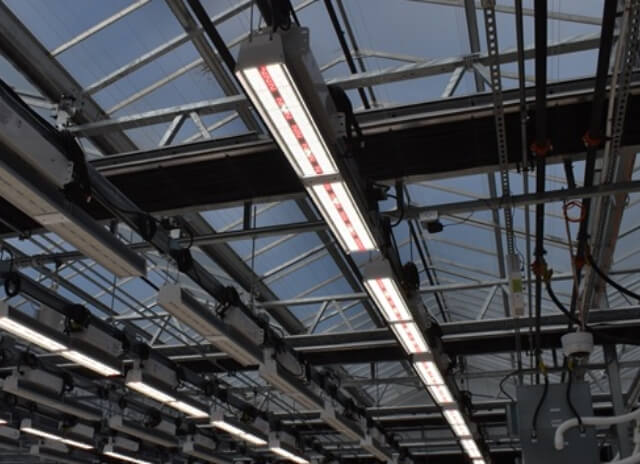
The primary user of electricity is from grow lighting, particularly in warehouse grows where sunlight is not accessible. Steps can be taken to increase the efficiency of this lighting by using LEDs and even focusing on high-efficiency red diodes. At the end of the day, to eliminate this energy cost, sunlight can be used in greenhouses, where often in the summer grow lighting will not be turned on where DLIs of 30+ are enjoyed.
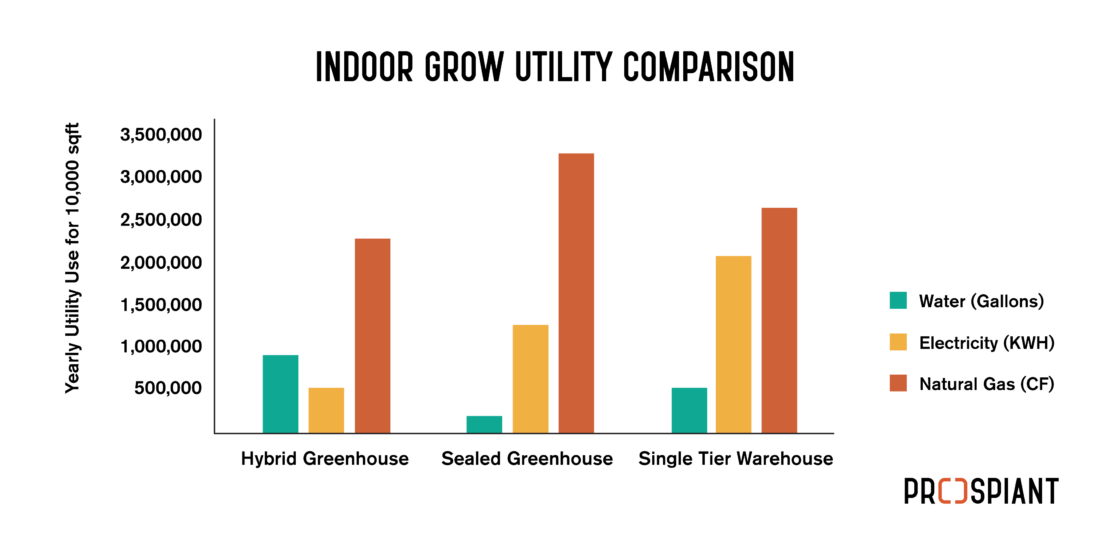
Capital Costs
Indoor warehouses and controlled environment greenhouses typically produce the same quality and yields of cannabis. Indoor facilities often can maintain higher environmental control, but greenhouses are able to get natural sunlight which improves terpene and cannabinoid content. Because selling prices between both cultivation systems are similar, what remains are the capital and operational costs.
When budgeting for a facility, costs per area are often desired. It is important to note that cannabis facilities enjoy economies of scale. This means that a 3,000 sqft facility may be double the cost per sqft as a 15,000 sqft facility, and quadruple that of an acre. Economies of scale are most notable for general contracting where initial costs for installation, utilities, and design have a significant impact. Facilities scaling up are also able to take advantage of irrigation and HVAC costs which scale well as a facility increases in size. The structure and systems for a new facility typically account for 2/3 of the total cost in which land, permitting, utilities, and excavation may account for the other 1/3.
Capital costs for a warehouse include buying/renting a space and retrofitting it or enacting a new build where utilities will need to be pulled. These typically amount to around $200-$450 per square foot. As indoor growers look to add additional tiers of cultivation, they can expect costs to increase by 50%-75% per tier. It should also be noted that single-tier layouts typically use 75%-85% of a room’s area whereas multi-tier layouts typically use 67% per tier, meaning a 3-tier grow room may achieve 200% of a room’s area as cannabis canopy.
On the greenhouse side, the sealed greenhouse is often twice the capital cost of a hybrid greenhouse. Cannabis greenhouse facilities typically range from $100-$500 per square foot. Facilities encompassing multiple hectares appreciate further economies of scale, particularly on the installation and commodity material supply side.
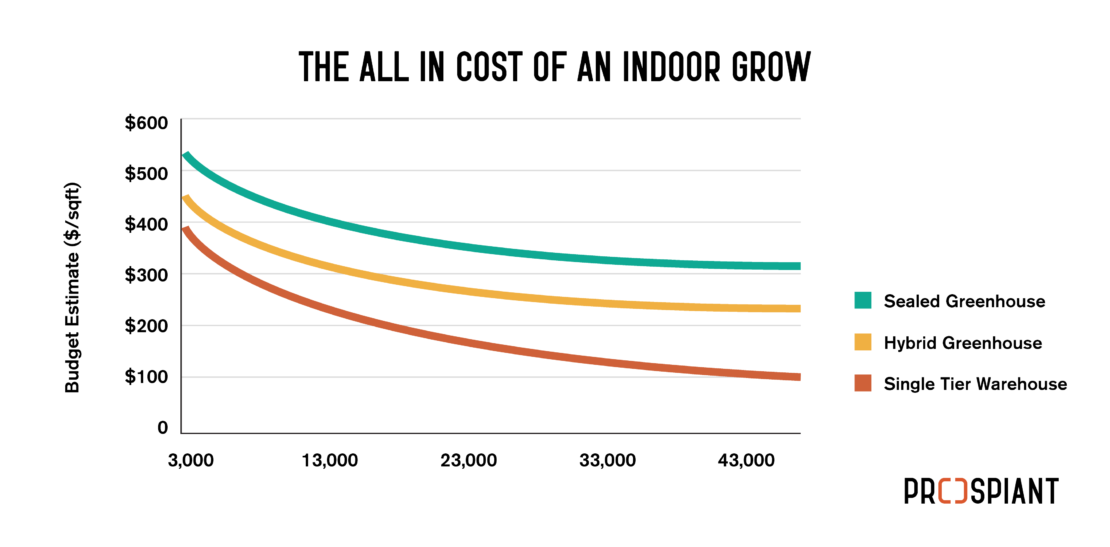
Current Trends and Expectations
To best choose a future facility, one must look at what the industry will become. Long-term sell prices for cannabis will continue to fall until a fine balance is met between cannabis supply and demand. As federal policies become more friendly interstate commerce will become possible and states will no longer need to produce their own cannabis, but instead could import. This will lead to cannabis being grown in pristine western climates as opposed to the more humid coastal climates of the east and south. In these harsher more humid climates warehouses or sealed greenhouses shine, unfortunately for them, cannabis will likely be grown elsewhere.
Survival of the Fittest
The cannabis industry isn’t the only one having the greenhouse versus warehouse debate. Leafy greens are experiencing a similar conversation. They speak about large urban farm plant factories as opposed to imported produce. The strongest arguments for these facilities are that they can locally produce leafy greens and that the permissible humidity levels for these crops are high. Neither of these strengths pair with cannabis as its product is dried and requires 20% less humidity.
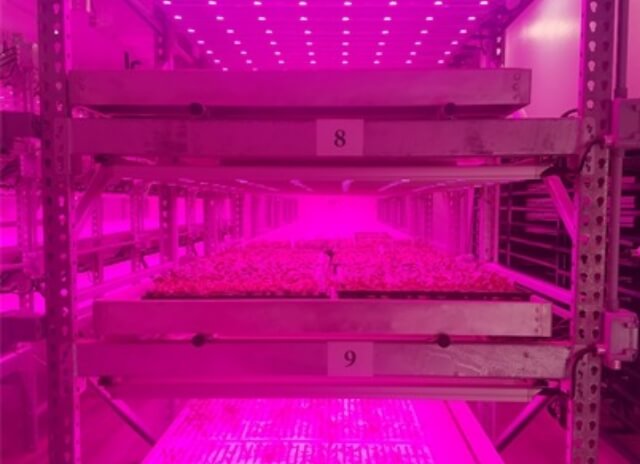
But for cannabis, in addition to seeing an increase of indoor operators, most of this year’s State of the Cannabis Cultivation Industry Report participants who cultivate cannabis (50%) indicated they also planned to add additional indoor space within the next two years. This is a 14-percentage point increase from 2020 and a 7-percentage point increase from 2016.
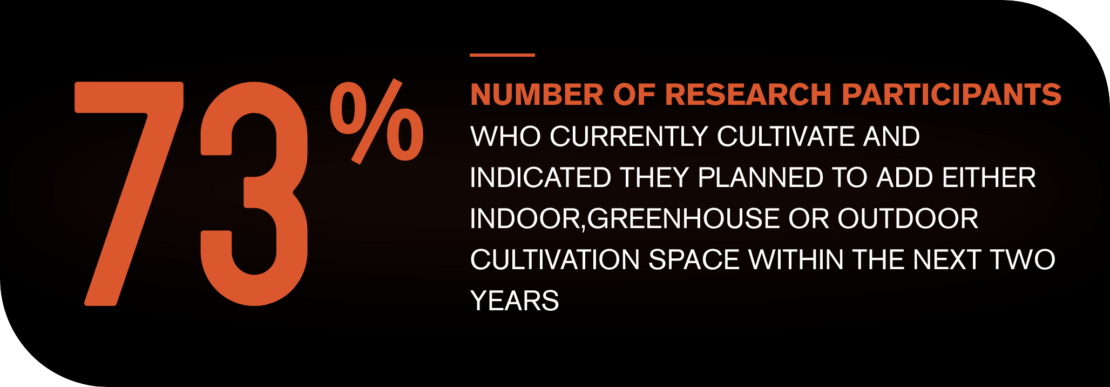
In contrast, just 32% of participants who currently cultivate indicated they are planning to add greenhouse space (down 13 percentage points from 2020 and 12 from 2016), and 21% indicated having plans to add outdoor space, a relatively stable finding compared with past years. A quarter (25%) of participants who currently cultivate indicated having no plans to add cultivation space.
Each year cannabis facilities get bigger and bigger, and the cannabis industry will continue to grow, but the number of suppliers may not. Those who stay cultivating in the industry will do it through know-how and efficiency, the future will tell which facility fits these credentials.
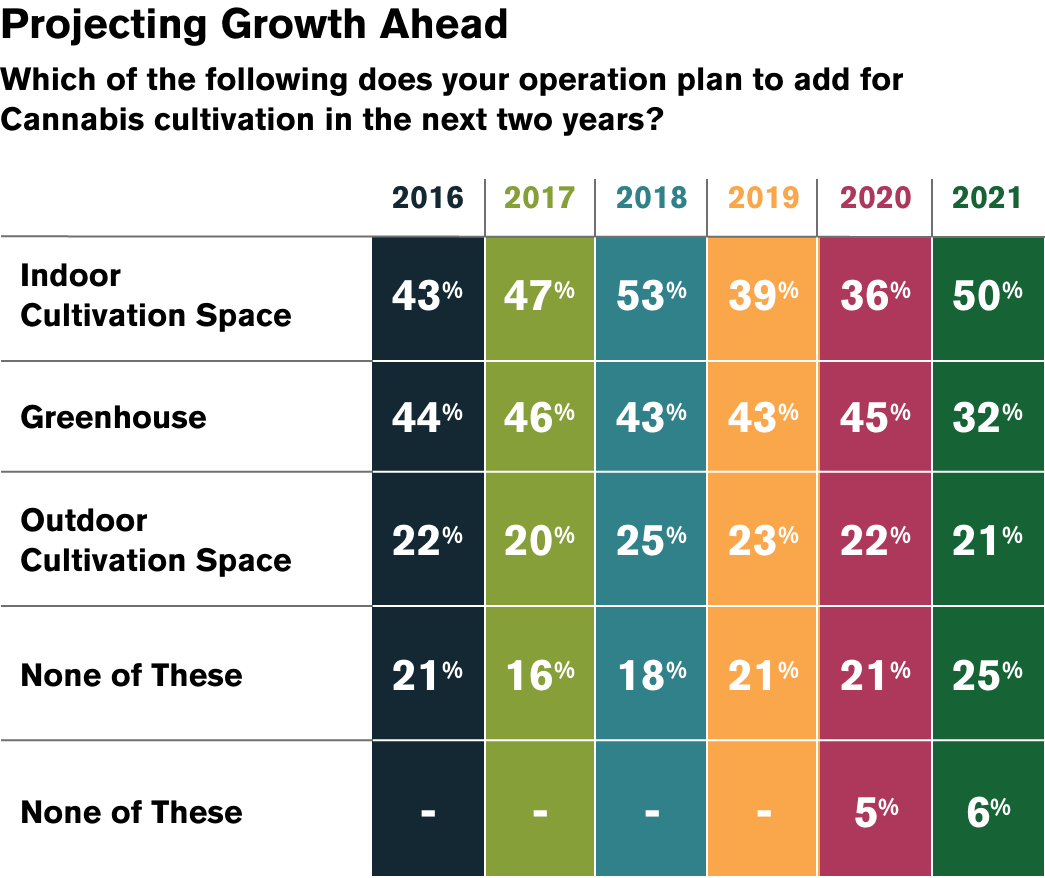
Achieving the Perfect Balance for Cannabis Cultivation
To learn more, read the next article in this series: How to Grow Cannabis: A Guide to Weed Cultivation: Finding the Perfect Balance of Air, Water, and Light.
*Data presented in this article is from the Cannabis Business Times 2021 State of the Industry Report, which examines the current cannabis cultivation market.